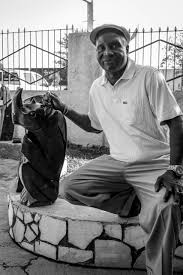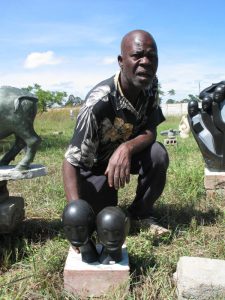You will find the collectors and first generation Shona sculptures from Zimbabwe
on our collectors and first generation Shona sculptures collection page
We ship worldwide
On this page we provide you with some general information about the history of the Zimbabwean sculpture art.
And a brief introduction to the first generation Shona sculptors from Zimbabwe we sell art from
Should you be interested you can also go directly to
Our general stone sculptures
or
our Dutch art pages
The first generation Shona sculptures from Zimbabwe
in our possession are collected by us over the last 20 upto 30 years. In total we have around 70 first generation Shona sculptures but it will take some time to show them online. Please be patient, we shall show them all in due time.
A few of them are always on display in our own sculpture garden in The Netherlands called "Beeldentuin B&N" ( in the Dutch language ). The majority is stored. Please write us before passing by at our garden.
The first generation Shona sculptors from Zimbabwe
start working in Zimbabwe at least since the 1950s. In those days they were mainly carving in soapstone and other soft materials ready available and usually for sale to tourists or local "rich" people.
Late 1950s a few sculptures, such as Loram Mariga, had broken away from the use of soft stones and started experementing with the harder stones from the Great Dycke.
Around 1960 Frank McEwen ( 1908-1994) was hired by the Rhodesian authorities to introduce a new breeze into the National Gallery of Rhodesia. One of the things he started with was a Workshop school. At first mainly in painting etc but also in sculpting. Soon he recognised the enormous potential of the work presented to him. He started to introduce new tools to these sculptors that allowed them to work in more detail also in the harder stones.
In 1958 the National Gallery hosted its first Annual Art Exhibition. Work from all over Rhodesia was presented including painting, scupture and other objects of art
History is not 100 % clear who did what precisely, why and when. Because of the succes of this exhibition several other galleries started promoting sculpturing.
One person we may not forget to mention:
Tom Blomefield, we met Tom at several occasions since 2006.
At the final stage of his life he lived for several years in our home country The Netherlands. He died in April 8th, 2020, aged 95.
December 6th 2020 his urn was placed in a sculpture specially made by the people of Tengenenge, Tom is home again.
Tom Blomefield had been a tobacco farmer in Guruve but due to the independence struggles lost this business. He stimulated his workers to start working in the stones found on his property. He formed a quite and nice community of sculptors called Tengenenge. (Also supported by Frank McEwen before he established his own rural workshop at Vukutu.)
Tengenenge then continued at its own path and still thrives today. Among others but probably the most famous sculptor of Tengenenge is Bernard Matemera but till today many sculptors that started working at Tengenenge are well known like the world famous Dominic Benhura.
We do realise this is just a very brief version of the whole story but much is already written and available on other websites.
We visited Tengenenge many times over the years.
We also stayed at Tengenenge for a longer time several times and around 2006 we asked a local friend to walk around at Tengenenge with our videocamera. Do not look for Tom because apparently he was just not around.
More videos can be found at our Youtube channel
Below we just give you a short history of the first generation sculptors of which we sell some work
Edward Chiwawa
Born in Guruve district in 1935 he worked as a farmer for many years.He visited his causin Henry Munyaradzi at Tengenenge and was first introduced to sculpting around 1971. As from around 1973 he started working at Chitungwiza.
Most commonly his work involves the creation of a  smooth, clean line - often gently rounded - into which is carved facial and other features, his sculpting technique essentially involves etching into the surface of the stone. His sculptures preserve rather than transform the original shape of the stone.
smooth, clean line - often gently rounded - into which is carved facial and other features, his sculpting technique essentially involves etching into the surface of the stone. His sculptures preserve rather than transform the original shape of the stone.
Damian Manuhwa
1952 - 2008, was born in Rusape district. A second generation sculptor. His father Fabian Manuhwa  carved in wood and Damian started working in wood as a little boy. When Damian met Joram Mariga this trigered him to start working in ston. In 1970 he started working at the Vukutu gallery of Frank McEwen. As many first generatio0n sculptors also Damian subjects are drawn largely from both the natural and the spiritual world. Allthough Damain has travelled overseas many times but his work is still loaded with ancint values and not swayed by external influences.
carved in wood and Damian started working in wood as a little boy. When Damian met Joram Mariga this trigered him to start working in ston. In 1970 he started working at the Vukutu gallery of Frank McEwen. As many first generatio0n sculptors also Damian subjects are drawn largely from both the natural and the spiritual world. Allthough Damain has travelled overseas many times but his work is still loaded with ancint values and not swayed by external influences.
Albert Nathan Mamvura
(1954-1997) Born in the Buhera district he grew up in a rural environment. He started working as a carpenter. Around 1975 his cousin Nicholas Mukomberanwa learned him the basis sculpting techniques. around 1978 he had work accepted by the National Galery for its anual exhibition.
Social sentiment was Mamvura's most dominant theme. His sculptures often incorporate figures closely entwined in a protective embrace. Mamvura's works are readily identifiable by his protrayal of the human form, the facial features of which are invariably similar in style.
A number of his later works showed a tendency toward abstraction.
Moses Masaya
1947 - 1996
He was an early student of Joram Maringa for about 2 years. During 1970 / 1974 he worked at the famous  Vukutu gallery of Frank McEwen at Nyanga.
Vukutu gallery of Frank McEwen at Nyanga.
He likes to show imagery, symbolism and religious morals in his sculptures. He sculpts evocative heads with stylised angular features to portray feelings
Bernard Matemera
Bernard Matemera is acknowledged to be one of Zimbabwe's master sculptors. Born in 1946 in the  Guruve district, he has spend his entire career at Tengenenge where he died on March 4th 2002. As a child he already showed great talent at wood carving and clay but it was Tom Blomefield that provided him with the most significant change in his life - stone. His work his always described as VERY strong, powerfull, uncompromising. Many people find it difficult to understand his sculptures because of it's strong African imagery but agree it can not be ignored and it remains on the retina for a longtime.
Guruve district, he has spend his entire career at Tengenenge where he died on March 4th 2002. As a child he already showed great talent at wood carving and clay but it was Tom Blomefield that provided him with the most significant change in his life - stone. His work his always described as VERY strong, powerfull, uncompromising. Many people find it difficult to understand his sculptures because of it's strong African imagery but agree it can not be ignored and it remains on the retina for a longtime.
Many of his sculptures ( like the one we own) bear the physical trademark of three toes and three fingers, a physiological fact amongst a community from which he began as an artist ( somebody ones told me he was a teacher in this community?)
Richard Mteki
Born in Harare in 1947, Richard's elder brother Boira was one of the first that astounded the international art world. Following his brother footsteps he joined the Vukutu school of art.
Vukutu school of art.
Mteki is much ionfluenced by the natural shape of a stone. His approach invariably is to etch deeply into the surface of the stone to creat the feature of his human, animal or other subjects. Despite his economical style, Mteki's work, though compact and solid, express much mood and motion. Invarablythey have a peaceful, restul quality.
It is perhaps because of Mteki's sculptures have a calming impact on the viewer that they are so universally popular. Great sculptures may sometimes disturb the viewer, may sometimes provoke strong ractions because of their style or subject matter, but they do not ahve to - and Mteki's do not. They are serene, they soothe the mind.
Sylvester Mubayi
Born in 1942 in the Chiota Reserve. At first he worked as a tobacco grader but moved to Harare in 1966 to seek employement. In 1967 he started working in Tengenenge. He was founder of the Vukutu workshop school of Frank McEwen. Frank said abou

t him: "At Vukutu he was by far the greatest sculptor, some of his work is as great as anything in the world.
Thereafter Sylvester worked and lived in Chitungwiza where we met him at several occasions ( and of course bought several pieces from him ) The picture I made around 2006. His work is inspired by a world of spirit and supernatural forces. Skeletons inspired his early work.
Claud Nyanhongo
was born in 1934 in the Nyanga district. He began sculpting as a leisure activity around 1964. Around 1980 he came to Harare and lived for several years with Moses Masaya. Since that time he has emerged as not only a serious full-time artist but also a successful one.
1980 he came to Harare and lived for several years with Moses Masaya. Since that time he has emerged as not only a serious full-time artist but also a successful one.
He prefers to work in the green serpentine stone found in his home region. He owns his own quarry from which he and his family works.
His forms, usually based on birds or humans, are invariably soft rounded, quiet en reflective, and follo the natural shape of the stone.
Brighton Sango
was born in 1958 in Guruve. He is a second generation sculpture and he was the first to break with the more  tradional Shona culture of the First Generation members. He started working at the Tengenenge community under the guidens of people like Bernard Matemera and many others. Already after one year he decided that he had to find "his own way". Allthough he had no exposure to "Western art" he started abstracting the subject in a way that is quite similar to people like Picasso and his cubism. Tragically, in August 1995, Brighton Sango took his own life.
tradional Shona culture of the First Generation members. He started working at the Tengenenge community under the guidens of people like Bernard Matemera and many others. Already after one year he decided that he had to find "his own way". Allthough he had no exposure to "Western art" he started abstracting the subject in a way that is quite similar to people like Picasso and his cubism. Tragically, in August 1995, Brighton Sango took his own life.
His way of sculpting "his signature" is still perfectly executed by his brothers





